| << Communauté et vidéos | Retour au menu principal | Découvrez RISC OS >> |
The Raspberry Pie contest
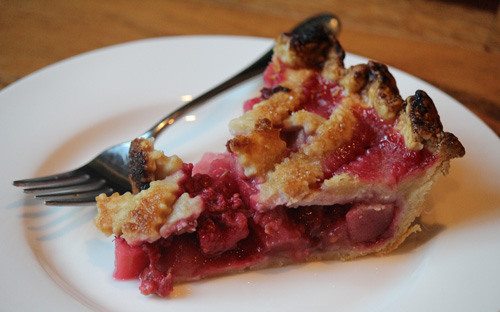
The Raspberry Pie contest is now officially over!
3 ways to win - 3 façons de gagner
Share an idea - Partagez une idéeShare a resource - Partagez une ressource
Surprise us - Surprenez-nous
The Winners / Les gagnants
Special prize - Clive Semmens
We did promise a free Raspberry Pi for the one who will guess what will be our surprise announcement. Clive guessed part of the content of the contest. "Aha! What you're really doing is trawling for ideas! Good plan." (https://www.riscosopen.org/forum/forums/1/topics/5299).
Clive wins a Raspberry Pi B Model. Old model, but 100% new.
Who will be the next one? Feel free to participate!
1 - Gavin Wraith
Here is a submission for an application, !Tangle, to demonstrate certain easily grasped topological concepts. !Tangle could be programmed in BASIC, for instance. I myself wrote a preliminary and more limited version in RiscLua using the toolbox two years ago.

!Tangle puts up a window displaying an NxN grid of sprites from the accompanying attached spritefile; N should be configurable by the user, but 32 might be a reasonable default. The sprites are all the same size. Each sprite has two components, each a red or green segment, either horizontal, vertical or diagonal. The sprites should be plotted, initially randomly, so that their common boundaries have matching colours. It will be seen that the resulting picture shows what in mathematics is called a "tangle" or a "link" of red or green threads, each of which is topologically a circle. The user should be able, by clicking on an icon, to change the icon displayed to another, satisfying the same constraint on boundary-colours.
There are 16 sprites in all, so that each picture can by represented by an NxN array of 4-bit values, constituting the "state" of the picture. The user should be able to save this state to a file and to reload it into the window.
This set-up presents a variety of interesting programming challenges, in addition to illustrating graphically some important concepts (for maths teachers for example).
Here are some concepts:
1. The "connected components" of a red or green thread. How to calculate their number, given a "state"?
2. An "orientation" of a connected component. A component acquires an orientation when each of its components is given an orientation.
3. The "winding number" of a pair of oriented links - including a link's self-winding number. How to calculate these?
4. If the icons at the edge of the window match up, left with right, up with down, then the window can be regarded as a "torus". Each oriented connected thread then defines a "homology class" of the torus: a pair of integers indicating how many times the thread winds round horizontally and vertically. How to calculate these?
5. Other topologies can be tried. For example, if the opposite edges of the window match up when reversed ( the left edge to the reverse of the right, the top edge to the reverse of the bottom) then the window can be regarded as a real projective plane. We can ask corresponding questions about the homology classes defined by an oriented connected component. Why do the orientations not matter in this case?
Other possibilities lie more in the direction of the thermodynamics of two-dimensional lattices. Assign an "energy" to each icon. What states minimize the total energy? Introduce for each pair of icons in the spritefile a "transition probability". This will define a Markov process in the space of "states". Appropriate symmetrical values should give rise to interesting moving pictures of the process.
Spritefile: https://www.riscos.fr/fichiers/contests/tangle.zip

!Tangle puts up a window displaying an NxN grid of sprites from the accompanying attached spritefile; N should be configurable by the user, but 32 might be a reasonable default. The sprites are all the same size. Each sprite has two components, each a red or green segment, either horizontal, vertical or diagonal. The sprites should be plotted, initially randomly, so that their common boundaries have matching colours. It will be seen that the resulting picture shows what in mathematics is called a "tangle" or a "link" of red or green threads, each of which is topologically a circle. The user should be able, by clicking on an icon, to change the icon displayed to another, satisfying the same constraint on boundary-colours.
There are 16 sprites in all, so that each picture can by represented by an NxN array of 4-bit values, constituting the "state" of the picture. The user should be able to save this state to a file and to reload it into the window.
This set-up presents a variety of interesting programming challenges, in addition to illustrating graphically some important concepts (for maths teachers for example).
Here are some concepts:
1. The "connected components" of a red or green thread. How to calculate their number, given a "state"?
2. An "orientation" of a connected component. A component acquires an orientation when each of its components is given an orientation.
3. The "winding number" of a pair of oriented links - including a link's self-winding number. How to calculate these?
4. If the icons at the edge of the window match up, left with right, up with down, then the window can be regarded as a "torus". Each oriented connected thread then defines a "homology class" of the torus: a pair of integers indicating how many times the thread winds round horizontally and vertically. How to calculate these?
5. Other topologies can be tried. For example, if the opposite edges of the window match up when reversed ( the left edge to the reverse of the right, the top edge to the reverse of the bottom) then the window can be regarded as a real projective plane. We can ask corresponding questions about the homology classes defined by an oriented connected component. Why do the orientations not matter in this case?
Other possibilities lie more in the direction of the thermodynamics of two-dimensional lattices. Assign an "energy" to each icon. What states minimize the total energy? Introduce for each pair of icons in the spritefile a "transition probability". This will define a Markov process in the space of "states". Appropriate symmetrical values should give rise to interesting moving pictures of the process.
Spritefile: https://www.riscos.fr/fichiers/contests/tangle.zip
Gavin wins a Raspberry Pi B Model. Old model, but 100% new.
Who will be the next one? Feel free to participate!
2 - John Dale
The supplied archive contains a directory structure to support a number of 8-bit educational titles running natively on the Raspberry Pi under RISCOS pico. All the programs are accessed through a MODE7 menu structure reminiscent of systems in use in the eighties. Some of them are still valid today for educational use in schools.
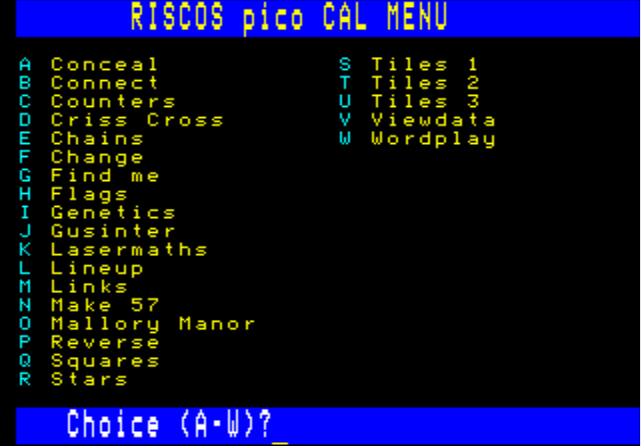
In the eighties the name Anita Straker was synonymous with quality mathematics and logic puzzle software. She was a prolific program writer and was known for the elegant simplicity of her MODE7 programs.
Genetics links to a suite of Biology programs from the Warwick Science Simulations, published by Longmans. These are exceptionally well-written and allow experimentation with genetics concepts. They were notable for the quality graphics they used.
The Lasermaths title is one of my own. It was written in 1981-82 under the Logical Educational Software label. Its claim to fame was twofold; shortly after it was released it featured on the BBC program "Pebble Mill at One" as an example of high quality educational software and latterly it proved to be one of the most-copied pieces of software throughout Derbyshire, Nottinghamshire and Leicestershire. At that time Education Authorities paid little attention to software copyright. Over the years I had lost this title and it was only when I was wading through over a 1000 floppy discs I had been loaned to archive that it came to light.
In the mid-eighties a company called CommunITel produced an amazing viewdata emulation system that had the ability to create and search viewdata databases. Viewdata was the world wide web of its day and spawned numerous bulletin boards. The software would run under emulation on the old Archimedes computers using !65Host but would not run natively on the Raspberry Pi as the software used 6502 code.
Since the BBC BASIC on the Raspberry Pi is pretty quick under RISCOS I re-engineered the search software to run natively in BASIC V. The Viewdata option from the menu can access and display two databases that I have collected, the original CommuITel demonstration database and an Econet manager's database from Acorn. I added to the original software functionality to allow the command D to switch between databases.
I have many more of these programs that will readily convert to RISCOS and I am still collecting. As well as educational titles I am looking to port some games. The Sphinx Adventure is one ready to roll out. All that is required is that the software be well-written, that the software does not use direct disc access to load files and that any machine code is generic and does not rely on the presence of BBC micro hardware.
Educational titles for RISC OS pico + documentation: https://www.riscos.fr/fichiers/contests/riscospicoconv.zip
Update: Jon used our Pi to design the ElectronPi:
http://www.stardot.org.uk/forums/viewtopic.php?f=16&t=11816

In the eighties the name Anita Straker was synonymous with quality mathematics and logic puzzle software. She was a prolific program writer and was known for the elegant simplicity of her MODE7 programs.
Genetics links to a suite of Biology programs from the Warwick Science Simulations, published by Longmans. These are exceptionally well-written and allow experimentation with genetics concepts. They were notable for the quality graphics they used.
The Lasermaths title is one of my own. It was written in 1981-82 under the Logical Educational Software label. Its claim to fame was twofold; shortly after it was released it featured on the BBC program "Pebble Mill at One" as an example of high quality educational software and latterly it proved to be one of the most-copied pieces of software throughout Derbyshire, Nottinghamshire and Leicestershire. At that time Education Authorities paid little attention to software copyright. Over the years I had lost this title and it was only when I was wading through over a 1000 floppy discs I had been loaned to archive that it came to light.
In the mid-eighties a company called CommunITel produced an amazing viewdata emulation system that had the ability to create and search viewdata databases. Viewdata was the world wide web of its day and spawned numerous bulletin boards. The software would run under emulation on the old Archimedes computers using !65Host but would not run natively on the Raspberry Pi as the software used 6502 code.
Since the BBC BASIC on the Raspberry Pi is pretty quick under RISCOS I re-engineered the search software to run natively in BASIC V. The Viewdata option from the menu can access and display two databases that I have collected, the original CommuITel demonstration database and an Econet manager's database from Acorn. I added to the original software functionality to allow the command D to switch between databases.
I have many more of these programs that will readily convert to RISCOS and I am still collecting. As well as educational titles I am looking to port some games. The Sphinx Adventure is one ready to roll out. All that is required is that the software be well-written, that the software does not use direct disc access to load files and that any machine code is generic and does not rely on the presence of BBC micro hardware.
Educational titles for RISC OS pico + documentation: https://www.riscos.fr/fichiers/contests/riscospicoconv.zip
Update: Jon used our Pi to design the ElectronPi:
http://www.stardot.org.uk/forums/viewtopic.php?f=16&t=11816
John wins a Raspberry Pi B Model. Old model, but 100% new.
Who will be the next one? Feel free to participate!
3 - Eric Safar
Athanor is a Point & Click game from Safar Games.
www.safargames.fr
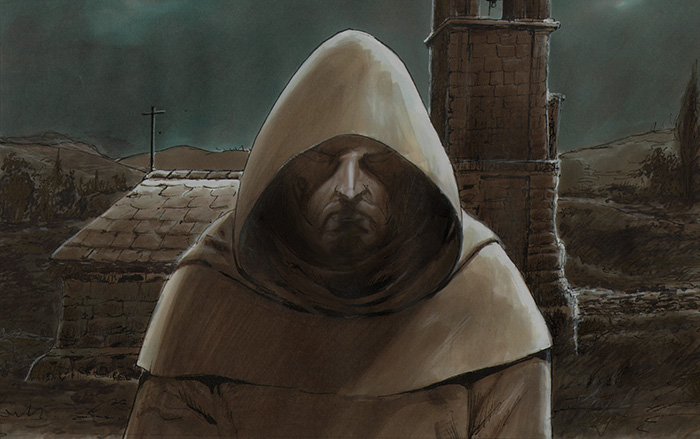
Eric Safar works on Athanor 2, for the Amstrad CPC and the Atari ST. He also plans to port his game on the Archimedes. With the help of a Raspberry Pi, Athanor 2 will be available under RISC OS.
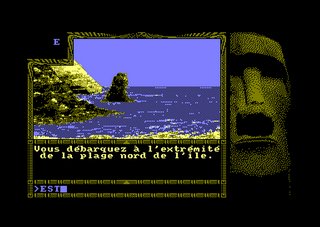
www.safargames.fr

Eric Safar works on Athanor 2, for the Amstrad CPC and the Atari ST. He also plans to port his game on the Archimedes. With the help of a Raspberry Pi, Athanor 2 will be available under RISC OS.

Eric wins a Raspberry Pi B Model. Old model, but 100% new.
Who will be the next one? Feel free to participate!
4 - Anthony Vaughan Bartram
RISC OS Synthesiser / Sound Engine. Codename 'Pluto'. This is a derivative work from Wavebox - A program written between 2000 and 2004 on Windows. Here is an archive of the latest version (it still works on Windows 10): https://www.riscos.fr/fichiers/contests/waveboxv21b.zip
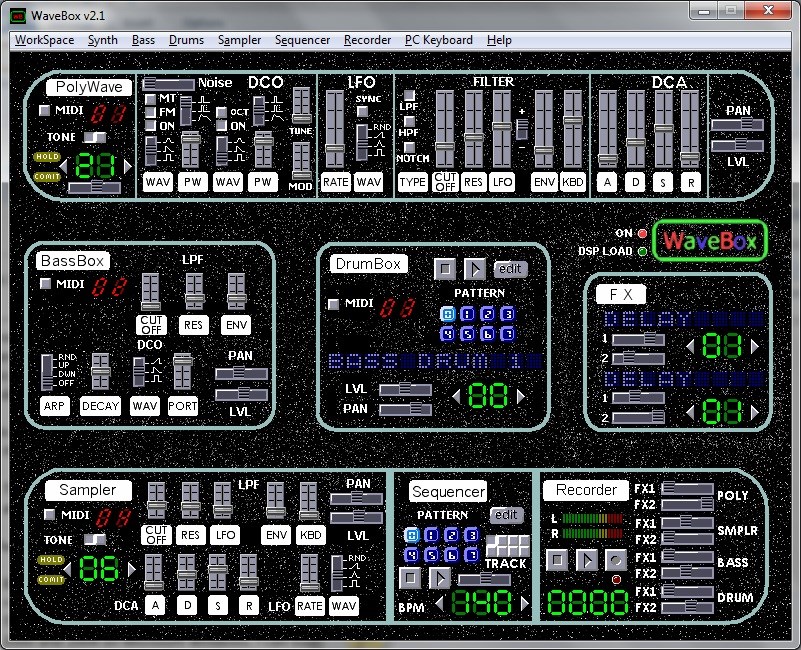
The sound engine is not the same as in Wavebox, although the code is based on the Wavebox DSP. Wavebox was based on a conventional virtual analogue synthesiser/sampler. For Pluto, inspiration is drawn from the BBC Micro, Amiga, Commodore 64 and some own analogue synthesiser collection to try and create something distinct and geared towards 'chip tunes' and sound effects.
Current state: 8 channel sound engine implemented as a standalone executable. Needs debugging/fixing, moving to a RISC OS Module and integration with SharedSound. This underlying RISC OS sound module will be free with source code included. A commercial tracker could be provided too.
Each channel has the following signal path:

The sound engine is not the same as in Wavebox, although the code is based on the Wavebox DSP. Wavebox was based on a conventional virtual analogue synthesiser/sampler. For Pluto, inspiration is drawn from the BBC Micro, Amiga, Commodore 64 and some own analogue synthesiser collection to try and create something distinct and geared towards 'chip tunes' and sound effects.
Current state: 8 channel sound engine implemented as a standalone executable. Needs debugging/fixing, moving to a RISC OS Module and integration with SharedSound. This underlying RISC OS sound module will be free with source code included. A commercial tracker could be provided too.
Each channel has the following signal path:
- Digital Oscillator: PWM / Saw / Triangle / Noise / Audio Sample.
- With Waveforms optionally combinable via an AND operator.
- With adjacent channels optionally combinable via an XOR operator.
- Attack Sustain Release Envelope.
- Attach Decay Sustain Release Envelope.
- 2 pole resonant low-pass filter.
- Effects: Chorus, Delay (i.e. echo), Distortion (i.e. overdrive) and Warm (a custom effect from Wavebox).
Anthony wins a Raspberry Pi B Model. Old model, but 100% new.
Who will be the next one? Feel free to participate!
5 - Chris Wraight
Chris works on a new version of the Othello game for RISC OS Desdemona. The first update since 2006. Welcome back Chris! This version will include better computer players, better graphics and a streamlined interface. It's currently being finished off, and it'll be released as a free download. Another game, Islands, could be updated later too.
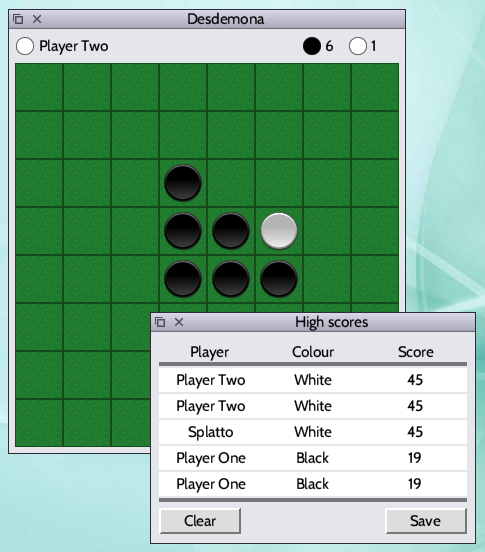

Chris wins a Raspberry Pi B Model. Old model, but 100% new.
Who will be the next one? Feel free to participate!
6 - Chris Hall
Chris wrote a utility to display a lot of information about a Raspberry Pi.
It's here: http://www.svrsig.org/software/ScrHelp.zip. And also available from !Store.
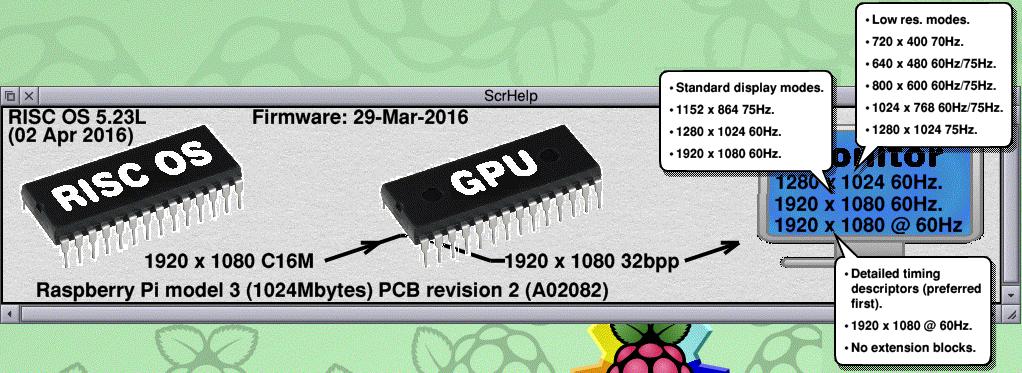
It's here: http://www.svrsig.org/software/ScrHelp.zip. And also available from !Store.

Chris wins a Raspberry Pi B Model. Old model, but 100% new.
Who will be the next one? Feel free to participate!
7 - David S.
David uses a Raspberry Pi to control a Prusa i3 type 3D printer. The software runs on RISC OS in single tasking mode. BBC BASIC is used to decode the G-code and control the output ports. The program scans the strings line per line, reads the G-code and calls a PROC for each supported command. This is interleaved with the output code that is sent to the I/O ports.
To drive the printer, the software uses 7 GPIO pins, where the upper 3 are wired to a 4 to 16 demux, and the lower 4 are used to output the stepper state, which is latched in 6 D-type transparent latches. Both are capable of going faster than the printer can handle. Then we have the drivers wired to the output of the D-type transparent latches, with a dedicated power supply.
A couple of passive components is used to make a Delta Sigma ADC for sampling the thermistors (bed and extruder temperature), and four pins are used for detecting the end/stop switch states.
It works, although the code is not production quality (it does not support all possible RepRap G-code).
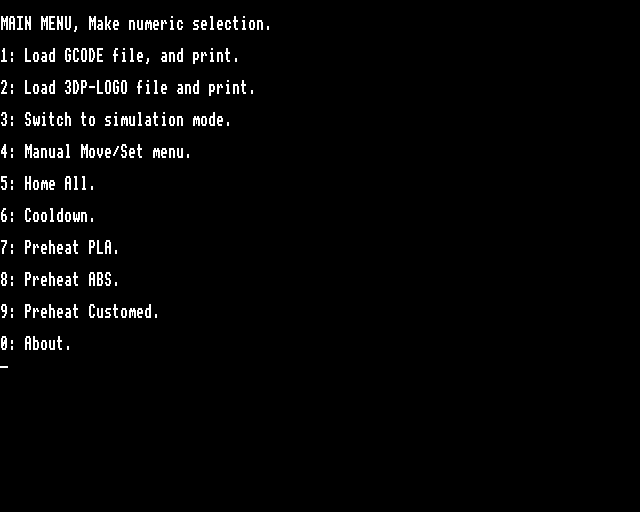
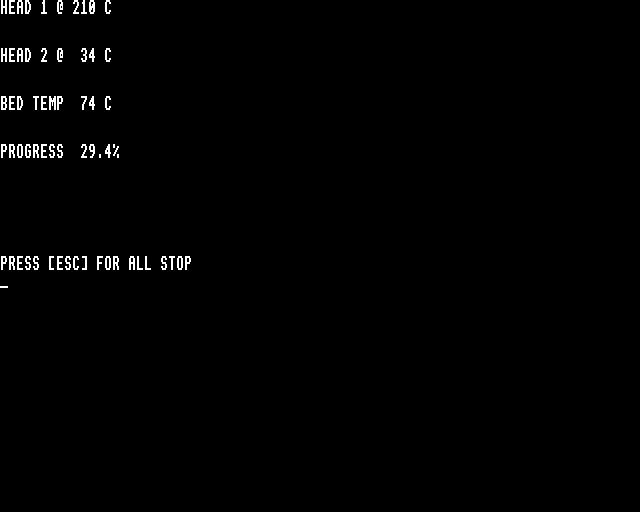
To drive the printer, the software uses 7 GPIO pins, where the upper 3 are wired to a 4 to 16 demux, and the lower 4 are used to output the stepper state, which is latched in 6 D-type transparent latches. Both are capable of going faster than the printer can handle. Then we have the drivers wired to the output of the D-type transparent latches, with a dedicated power supply.
A couple of passive components is used to make a Delta Sigma ADC for sampling the thermistors (bed and extruder temperature), and four pins are used for detecting the end/stop switch states.
It works, although the code is not production quality (it does not support all possible RepRap G-code).


David wins a Raspberry Pi B Model. Old model, but 100% new.
Who will be the next one? Feel free to participate!
8 - Tristan Mumford
Tristan Mumford tried to find a way to easily control the GPIO pins under RISC OS for a robotic project. The result is the library "Lib RO GPIO" (librogpio). It only supports simple pin control so far, but it does it well.
The interface is written to be very simple, like in Arduino and WiringPi. The idea is that it makes RISC OS a more appealing platform for people who want to learn and experiment. Coming to it recently itself, Tristan found the learning curve to be very steep and difficult. Hopefully librogpio will make the first step a little easier.
The photo shows the control of a stepper motor using librogpio. Atop the Pi is a prototyping board which provides a RTC, PWM audio output and pins for connecting DuPont wires to for easy connection, just like the stepper controller.
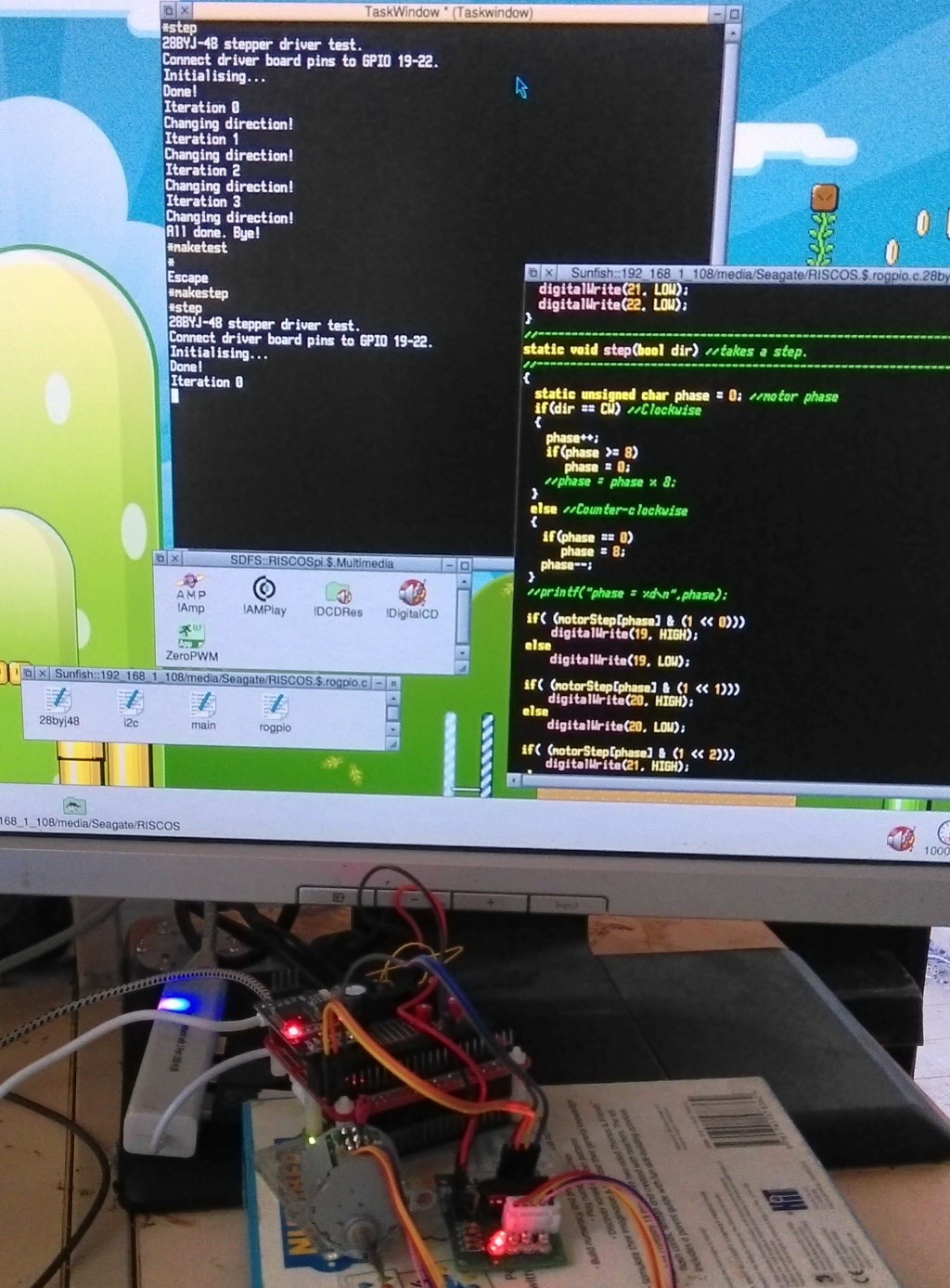
The interface is written to be very simple, like in Arduino and WiringPi. The idea is that it makes RISC OS a more appealing platform for people who want to learn and experiment. Coming to it recently itself, Tristan found the learning curve to be very steep and difficult. Hopefully librogpio will make the first step a little easier.
The photo shows the control of a stepper motor using librogpio. Atop the Pi is a prototyping board which provides a RTC, PWM audio output and pins for connecting DuPont wires to for easy connection, just like the stepper controller.

Tristan wins a Raspberry Pi B Model. Old model, but 100% new.
Who will be the next one? Feel free to participate!
9 - Mirko Vidovic
Mirko Vidovic wrote a full page about RISC OS on the Raspberry Pi, in the 29th issue of the French magazine Le Virus Informatique. Mirko is famous in the RISC OS community: in the 90s he was known as the leader of the French club ARMada.
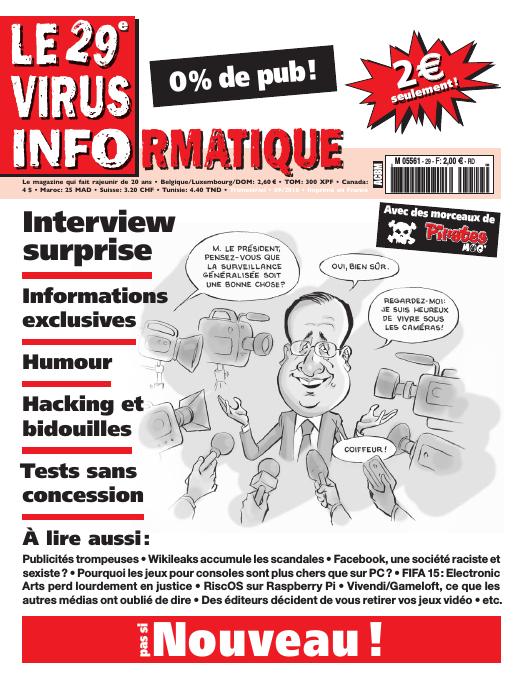

Mirko wins a Raspberry Pi B Model. Old model, but 100% new.
Who will be the next one? Feel free to participate!
10 - Richard Hallas
Richard provided two new sets of RISC OS backdrops in high resolution. The first one is dedicated to Raspberry Pi systems, with three 5120x2880 images. A must! The second one is for Iyonix pc users, with two 2560x1440 backdrops.
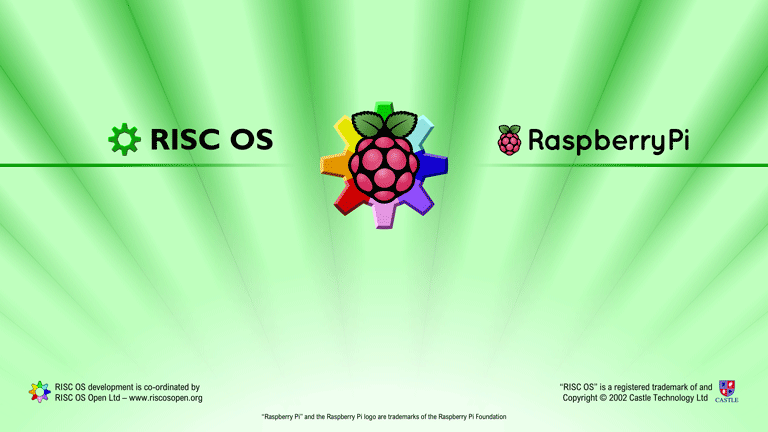
Raspbery Pi backdrops
The three Raspberry Pi backdrops were created for RISC OS Pi at the request of RISC OS Open Ltd and are supplied with RISC OS Pi. These new hi-res 5K versions are new renders of the existing assets at a much higher resolution than before. The sun-rays image is the PreDesk start-up image seen while booting, and isn't otherwise available as a backdrop image.
Iyonix pc backdrops
The 'Inside Iyonix' image was created to celebrate the launch of the Iyonix pc in 2002, and a version of it was used as the cover image for issue 11 of Foundation RISC User magazine. Similarly, the birthday backdrop was created in 2003 to celebrate the Iyonix's first anniversary, and was used on the cover of Acorn User magazine issue 266 (December 2003).

Raspbery Pi backdrops
The three Raspberry Pi backdrops were created for RISC OS Pi at the request of RISC OS Open Ltd and are supplied with RISC OS Pi. These new hi-res 5K versions are new renders of the existing assets at a much higher resolution than before. The sun-rays image is the PreDesk start-up image seen while booting, and isn't otherwise available as a backdrop image.
Iyonix pc backdrops
The 'Inside Iyonix' image was created to celebrate the launch of the Iyonix pc in 2002, and a version of it was used as the cover image for issue 11 of Foundation RISC User magazine. Similarly, the birthday backdrop was created in 2003 to celebrate the Iyonix's first anniversary, and was used on the cover of Acorn User magazine issue 266 (December 2003).
Richard wins a Raspberry Pi B Model. Old model, but 100% new.
Who will be the next one? Feel free to participate!
11 - Benoît Gilon
Benoît is now back on the development of Tag, "The hAndwriting recognition enGine". Tag is a small freeware (source provided) dynamic handwriting recognition engine. Tag is written in BBC Basic, without floating point (as much as possible).
Benoît made a live demonstration of this tool two years ago at the A2FF (Apple 2 Festival France):
https://youtu.be/WSU1dZ2FnBY?t=31m10s
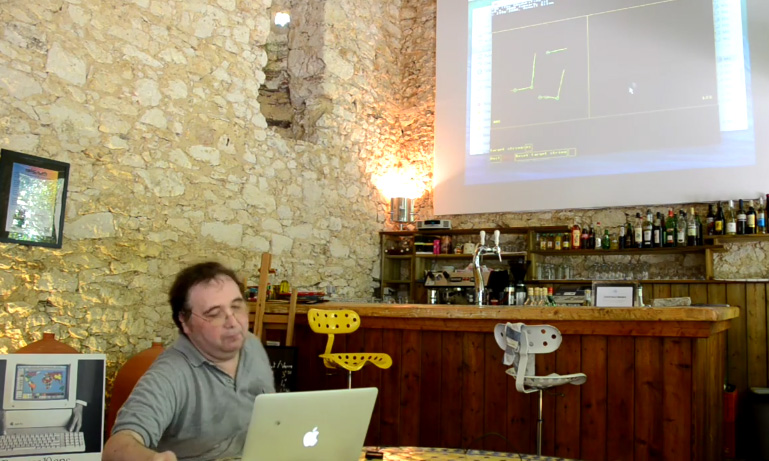
More details on the project are here:
http://bgilon.free.fr/RISCOS/tag/main.htm
Benoît made a live demonstration of this tool two years ago at the A2FF (Apple 2 Festival France):
https://youtu.be/WSU1dZ2FnBY?t=31m10s

More details on the project are here:
http://bgilon.free.fr/RISCOS/tag/main.htm
Benoît wins a Raspberry Pi B Model. Old model, but 100% new.
Who will be the next one? Feel free to participate!
12 - Alain Leraut
Alain made a good joke (in French) about "la mise en bière d'Acorn" (to put Acorn in the coffin / some acorn beer).
Fortunatley, RISC OS is still alive!
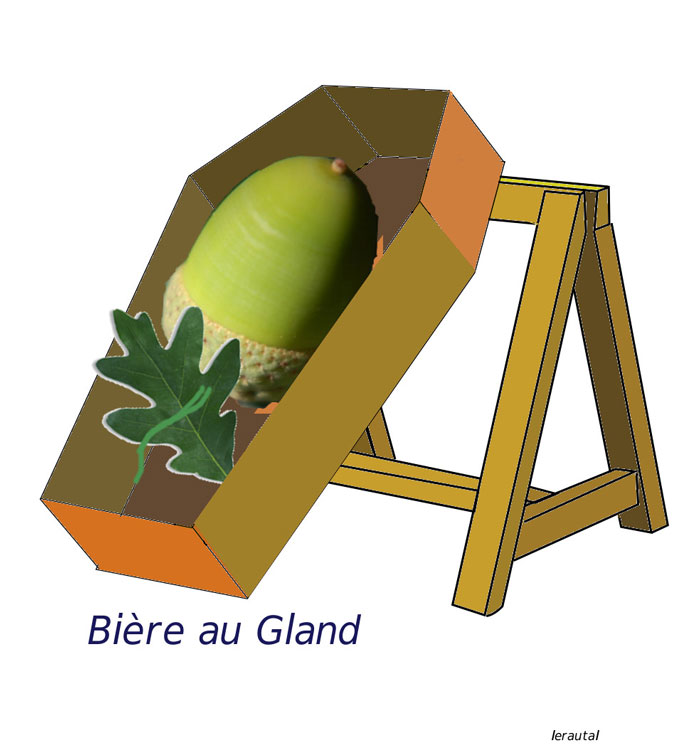
Fortunatley, RISC OS is still alive!

Alain wins a Raspberry Pi B Model. Old model, but 100% new.
Who will be the next one? Feel free to participate!
13 - Rick Murray
Frobnicate is back… en français. Rick delivered a new edition of Frobnicate, in French. Made on a RISC OS computer and published under a Creative Commons license.
"I know that Frobnicate #30, in 2008, was to be the final issue [...]. I was not planning on writing another issue of Frobnicate, however the irrepressible David Feugey of RISC OS FR talked me into it. And with Brexit on the horizon, it seemed like a good opportunity to see how much my French sucks!"
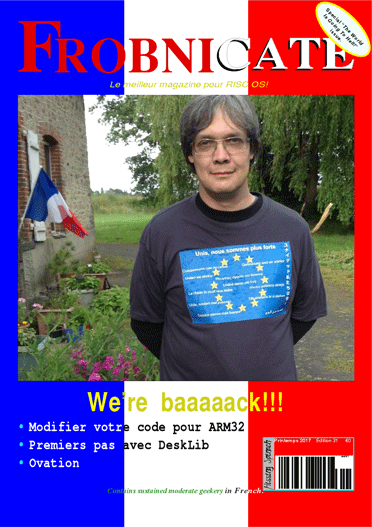
Read more here: https://www.riscos.fr/frob31/
"I know that Frobnicate #30, in 2008, was to be the final issue [...]. I was not planning on writing another issue of Frobnicate, however the irrepressible David Feugey of RISC OS FR talked me into it. And with Brexit on the horizon, it seemed like a good opportunity to see how much my French sucks!"

Read more here: https://www.riscos.fr/frob31/
Rick wins a Raspberry Pi B Model. Old model, but 100% new.
Who will be the next one? Feel free to participate!
14 - Simon Ferré
Simon has a basic telescope, a Meade 4500. It is on a tripod mount but it only has manual controls.
Simon proposes a system to control the telescope using a Raspberry Pi, a battery to provide power, and software to controls the position of the telescope using motors. It could also include a camera attached to the end of the eyepiece to capture photographs or video, and/or view the image on a TV.
The Raspberry Pi could be attached to the telescope, or simply the controls and motors, and camera attached to the telescope, with the Raspberry Pi connected to a TV inside the house, with a remote control to pan around.
Simon's wife would love to take part in this hobby but she feels the cold so doesn't go outside to view the images. But if they were displayed on the family's TV, she could see what Simon gets to see, from the comfort of the home.
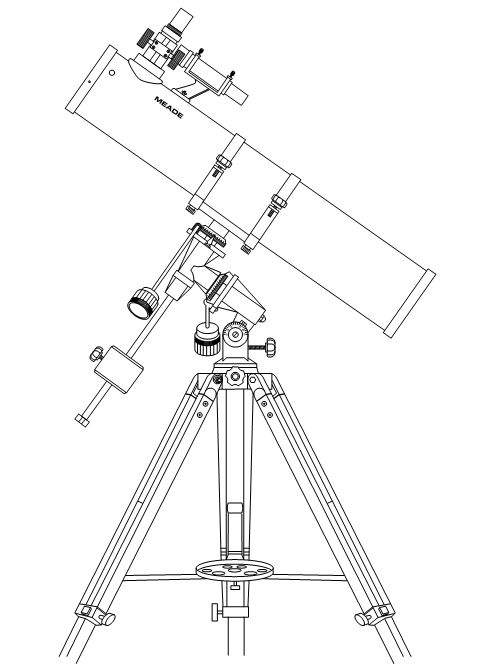
Simon proposes a system to control the telescope using a Raspberry Pi, a battery to provide power, and software to controls the position of the telescope using motors. It could also include a camera attached to the end of the eyepiece to capture photographs or video, and/or view the image on a TV.
The Raspberry Pi could be attached to the telescope, or simply the controls and motors, and camera attached to the telescope, with the Raspberry Pi connected to a TV inside the house, with a remote control to pan around.
Simon's wife would love to take part in this hobby but she feels the cold so doesn't go outside to view the images. But if they were displayed on the family's TV, she could see what Simon gets to see, from the comfort of the home.

Simon wins a Raspberry Pi B Model. Old model, but 100% new.
Who will be the next one? Feel free to participate!
15 - Jean-Michel Bruck
Jean-Michel is one of the most active RISC OS developers on the French scene today. He won his award for his work around Psion support under RISC OS 5.
Since then, he also worked on math, Midi, USB, XML and other topics. He also wrote Diderot, a tool for managing DDE projects. Many very useful software for RISC OS. More here: https://jeanmichelb.riscos.fr/Programmes.html
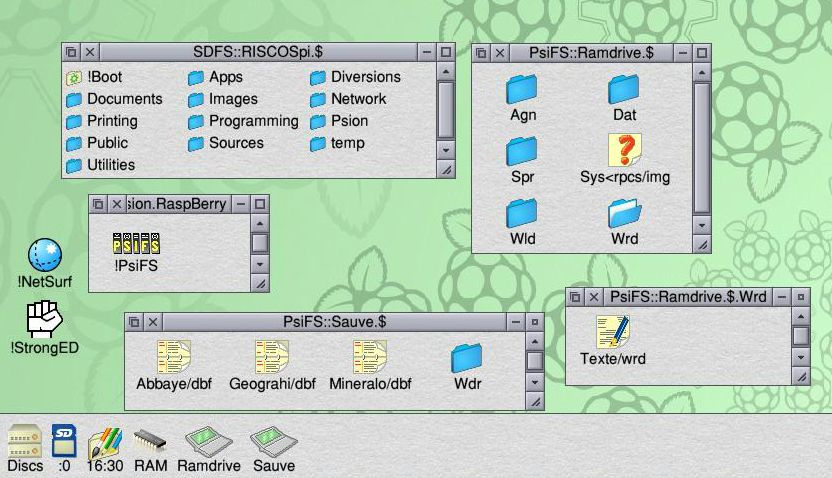
Since then, he also worked on math, Midi, USB, XML and other topics. He also wrote Diderot, a tool for managing DDE projects. Many very useful software for RISC OS. More here: https://jeanmichelb.riscos.fr/Programmes.html

Jean-Michel wins a Raspberry Pi B Model. Old model, but 100% new.
Who will be the next one? Feel free to participate!
16 - Jean-Pierre Weber
Jean-Pierre is not only a man of the wave, but also of the ware. Software and hardware. For sailing, he uses today a Raspberry Pi under Raspbian, with open source navigation software.

But Jean-Pierre is also working on several other hardware and software projects, with a RISC OS one... and he needs some hardware for their development.
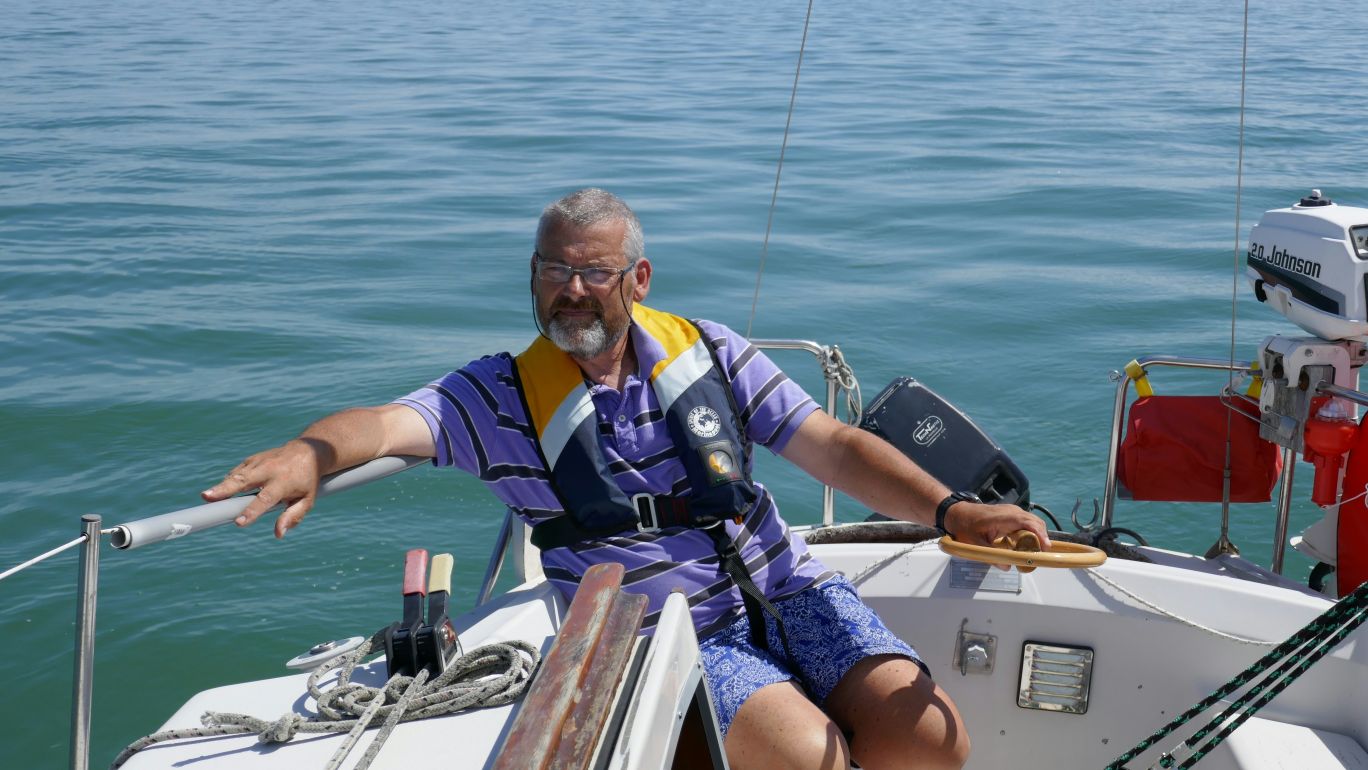

But Jean-Pierre is also working on several other hardware and software projects, with a RISC OS one... and he needs some hardware for their development.

Jean-Pierre wins a Raspberry Pi B Model. Old model, but 100% new.
Who we'll be the next one? Feel free to participate!
17 - Michel Osselin
Michel is known for his key role in the FrAUG (French Acorn User Group). He no longer uses RISC OS, but still has a lot of RISC OS hardware and software. You've probably seen him at one of the last English shows.
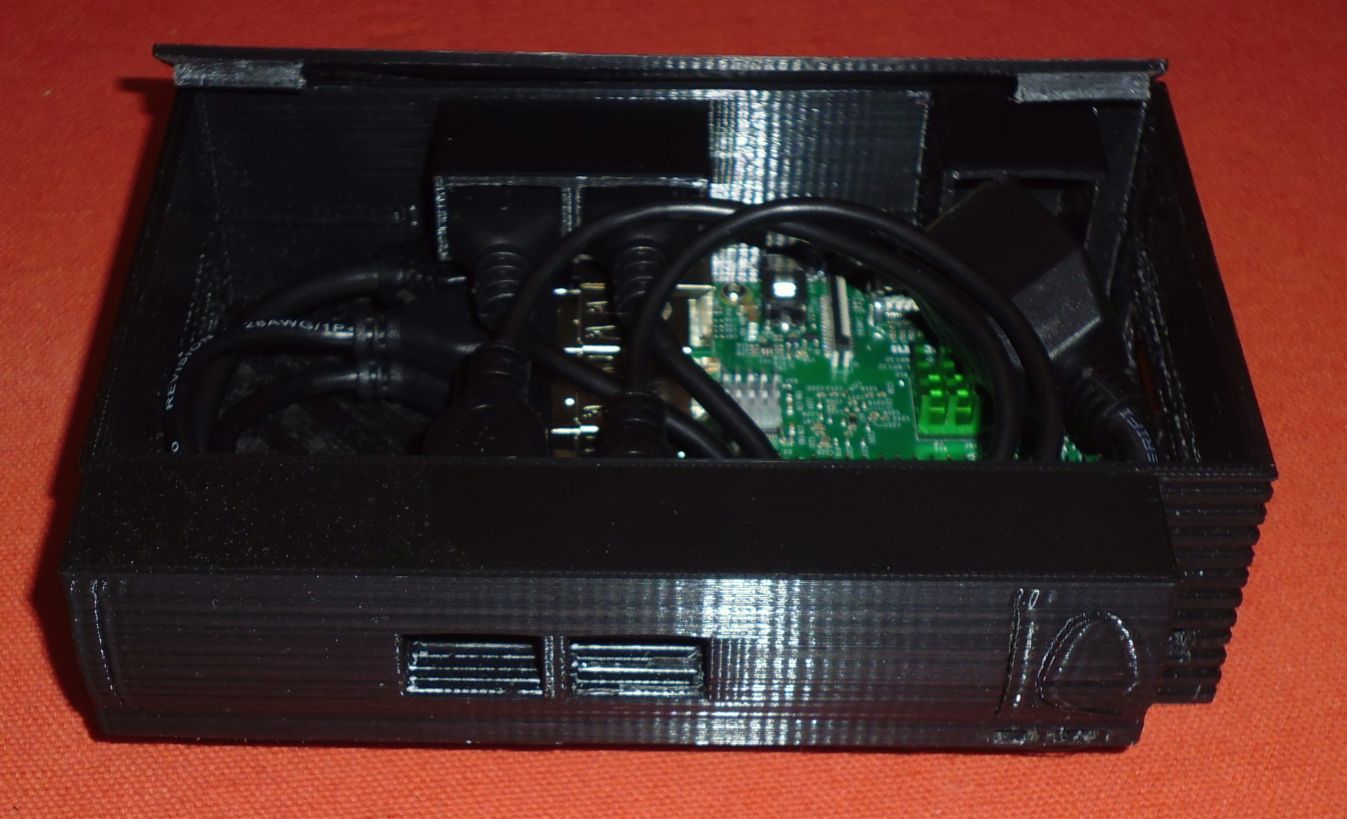
Michel surprised us with a 3D printed case that mimics the RISC PC. The template comes from this site: http://www.dorchester3d.com/printing/blog/2016/06/raspberry-pi-acorn-risc-os-case
Ah, and Michel is also another accomplished sailor.
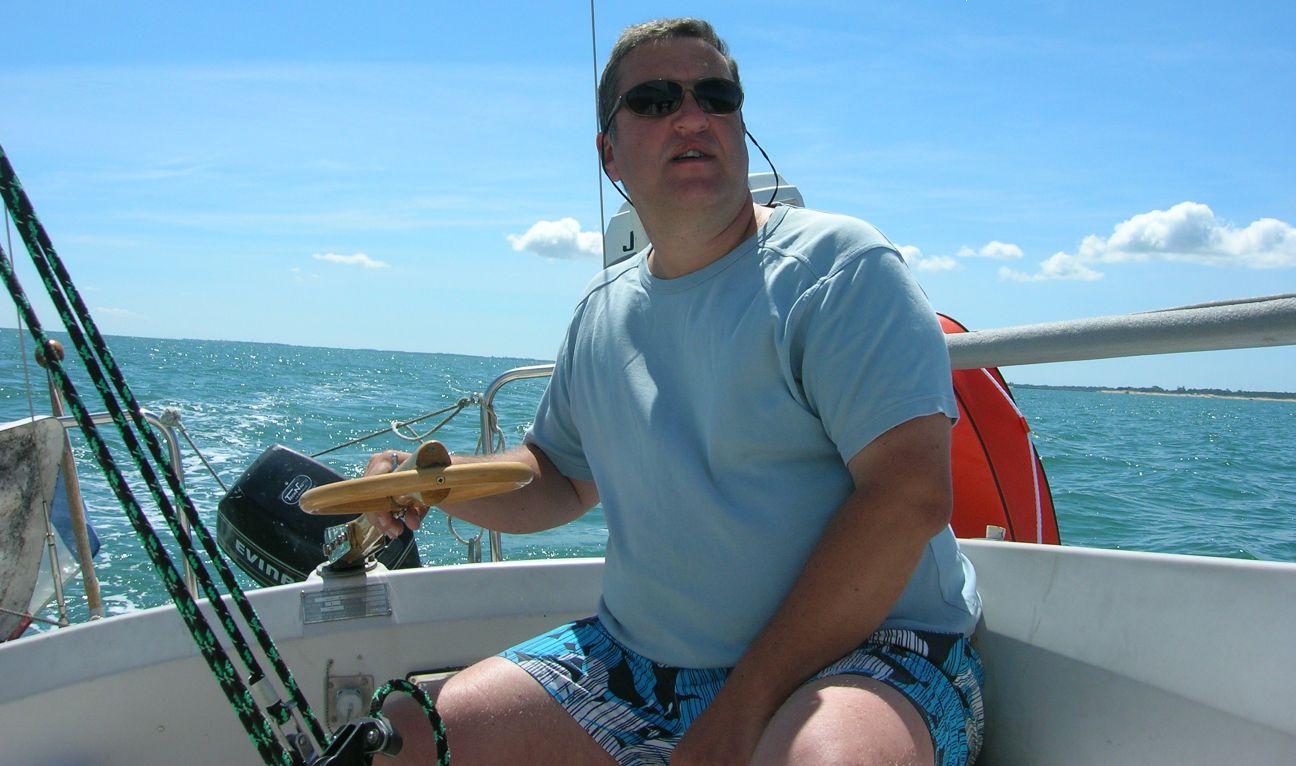

Michel surprised us with a 3D printed case that mimics the RISC PC. The template comes from this site: http://www.dorchester3d.com/printing/blog/2016/06/raspberry-pi-acorn-risc-os-case
Ah, and Michel is also another accomplished sailor.

Michel wins a Raspberry Pi B Model. Old model, but 100% new.
Who we'll be the next one? Feel free to participate!
18 - Xavier Tardy
Xavier "Zarchos" is well known on the retro scene, with a strong presence on some forums and many projects. For example a future museum, largely dedicated to Acorn computers.
Zarchos made a selection of videos in 2017... some of them for other websites, helping to inform the whole community about the RISC OS ecosystem. This one last 4 hours and was made for a Spanish website, Amiten TV (in English): https://www.youtube.com/watch?v=ZS3-x9cCZxk
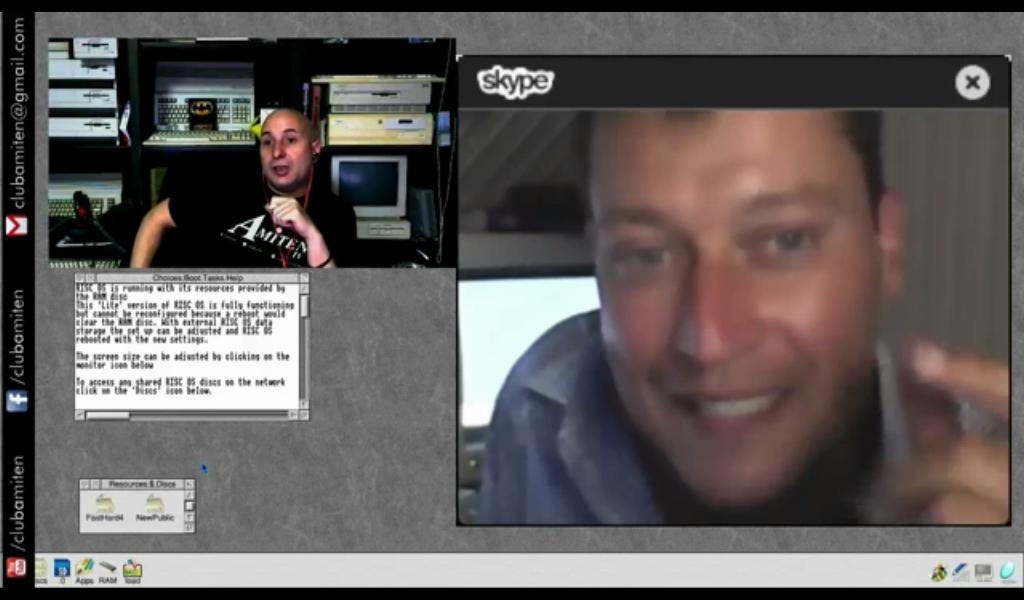
Zarchos made a selection of videos in 2017... some of them for other websites, helping to inform the whole community about the RISC OS ecosystem. This one last 4 hours and was made for a Spanish website, Amiten TV (in English): https://www.youtube.com/watch?v=ZS3-x9cCZxk

Xavier wins a Raspberry Pi B Model. Old model, but 100% new.
Who we'll be the next one? Feel free to participate!
19 - Jean-Marc Levasseur
Jean-Marc is working on a scenographic project that will implement music and light. Being a historical user of Acorn computers, RISC OS is one of the options he is studying. Jean-Marc shares some pictures of his MIDI works.
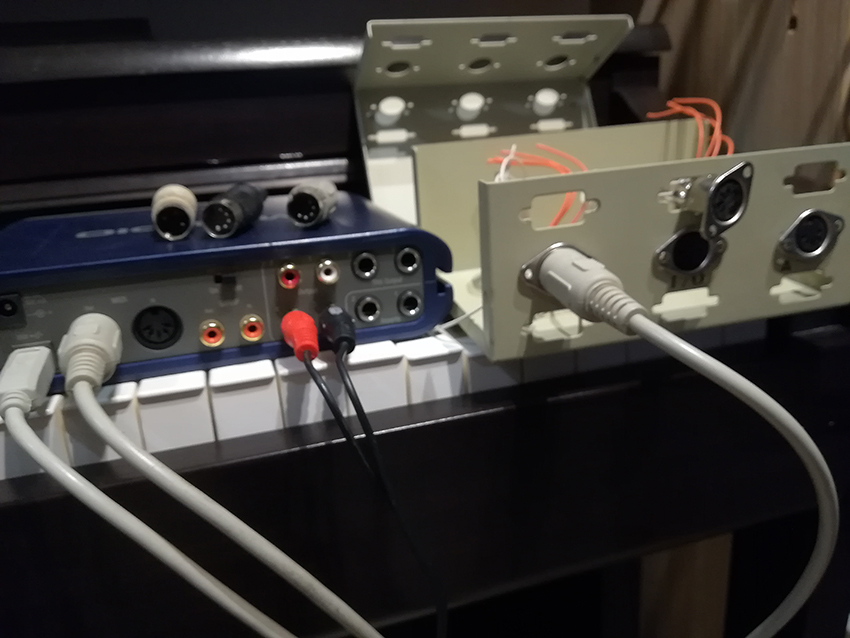
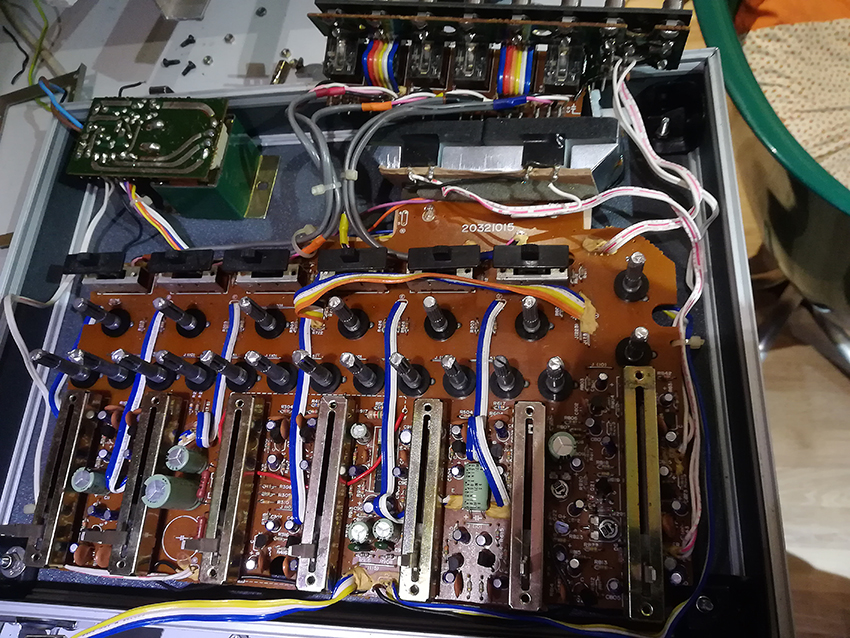


Jean-Marc wins a Raspberry Pi B Model. Old model, but 100% new.
Who we'll be the next one? Feel free to participate!
20 - John Hogg
John would like to work on a home automation project. Both hardware and software, with articles covering the build and software development to show the modern use of RISC OS.
John describes his project: "I was wondering what will bring more people to RISC OS, not just having a quick blast from the past. We need new programmers and people to use it more. RISC OS was always amazing for DIY electronics, control systems, etc. So a project that people could follow over a series of articles, to make something like a thermostat and learn how easy it is to code your project. Then learn some more advanced programming adding the smart functions. It could be a really good thing to get people to try out RISC OS for more than just a bit of fun and learn some programming too that could maybe help in their next project."
John describes his project: "I was wondering what will bring more people to RISC OS, not just having a quick blast from the past. We need new programmers and people to use it more. RISC OS was always amazing for DIY electronics, control systems, etc. So a project that people could follow over a series of articles, to make something like a thermostat and learn how easy it is to code your project. Then learn some more advanced programming adding the smart functions. It could be a really good thing to get people to try out RISC OS for more than just a bit of fun and learn some programming too that could maybe help in their next project."
John wins a Raspberry Pi B Model. Old model, but 100% new.
The Raspberry Pie contest is now officially over!
Raspberry Pie © elizaraxi - CC BY 2.0 / Cliparts © mondspeer - Public Domain

| << Communauté et vidéos | Retour au menu principal | Découvrez RISC OS >> |